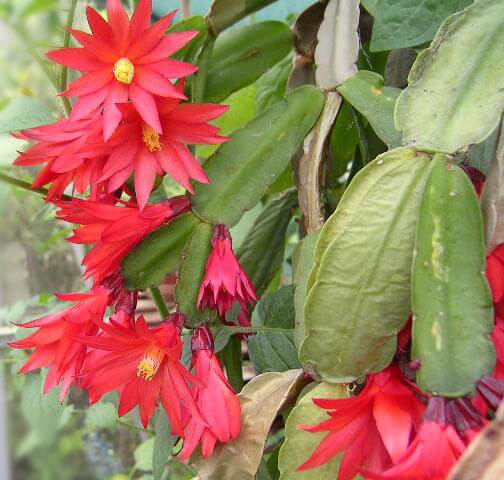Plant Care Instructions for Easter Cactus (Schlumbergera gaertneri), Easter Cactus repotting, care tips, lighting, soil, watering, temperature tips.
- Name : Easter Cactus (Schlumbergera gaertneri)
- Light: lots of light
- Temperature: 70° to 75° F – 21° to 24° C
- Humidity: 20% to 30%
- Soil: “cactus”
- Watering: lightly, once a week
- Spraying: weekly
This cactus is commonly found growing among trees. In the spring, it produces a great number of small red flowers. It requires no sun, but lots of light. It should be fertilized to maintain good growth except from early February until floral buds appear. It also needs regular watering except during its short rest period at the beginning of February when watering should be reduced. For maximum health, it should be kept stationary and moved around as little as possible.
After flowering, you may propagate your plant. Cut off sections of the stem and root them in a slightly moist, sandy soil. You may also repot at this time. In the summer, it will do well outdoors as long as you have a slightly shady place for it.

Source : wikipedia.org
How to care for indoor plants of Easter Cactus
Hybridization has provided us with a large number of beautiful and unusual plants to choose from when decorating our homes. The cactus family is a perfect example of the spectrum of available plants. Holiday plants, such as the Christmas and Easter cactus, are the hybrids of the Brazilian forest cactus. These segmented plants bloom at certain times of the year, which gives them the holiday designations.
What is the difference between a Christmas cactus and an Easter cactus?
The Thanksgiving and Christmas cactus (Schlumbergera bridgesii) are members of the Schlumbergera family, while the Easter cactus is a Rhipsalidopsis. The first comes from Brazilian rainforests, while the second is from drier forests.
The Christmas cactus blooms around the winter holidays. The cactus plant of Easter blooms in late winter until early spring. Both types have flattened stems, called segments, that are slightly jagged at the edges. The segments are actually the leaves of the plant.
About the Easter cactus plant
The Easter cactus plant (Rhipsalidopsis gaertnerii) comes in a variety of flower colors. They are usually in bloom at the time of purchase and are common holiday gifts. The shades of flowers range from white to red, orange, peach, lavender and pink.
Even after its flowering, the plant has an interesting appeal in its unusual form. The segments are added by new growth, creating a rickety stacked appearance. The plant does not have the same thorns as a dessert cactus, but a more wavy shape with softer pointed nodes at the edges of the leaves.
Making an Easter cactus flourish next year requires a special set of conditions that amount to a form of abandonment.
How to care for the Easter Cactus
These plants work best with bright light, but not with direct sunlight. Unlike dessert cacti, these plants need cooler temperatures, even during the day, and will flower for months at night temperatures of 55 to 60 degrees F. (13-16 C.).
Keep the soil slightly moist and allow it to dry before re-watering. Good care of the Easter cactus means transplanting the plant every two years in spring. The plants enjoy being tied to the pot, but they give it a new soil and return the plant to the same pot. Fertilize monthly after the flowering period with 10-10-10 or foods with low nitrogen count.
Provide some moisture if your house is dry. Place the plant on a saucer filled with pebbles and a little water. The evaporation will moisten the air around the plant.
Get an Easter cactus to bloom
If you faithfully followed your Easter cactus care, you should have a healthy green cactus. These delicious plants really need cool temperatures and long nights to set buds. To achieve flowers, you must be a little rude to them.
First stop feeding them. Then move the plant where it has 12 to 14 hours of darkness. The best set of shoots occurs when temperatures are 50 F (10 C.). Water sparingly from October to November. By December, you can move the plant to a warmer place with a range of 60 to 65 degrees (16-18 C.). The plant will bloom in February to March.